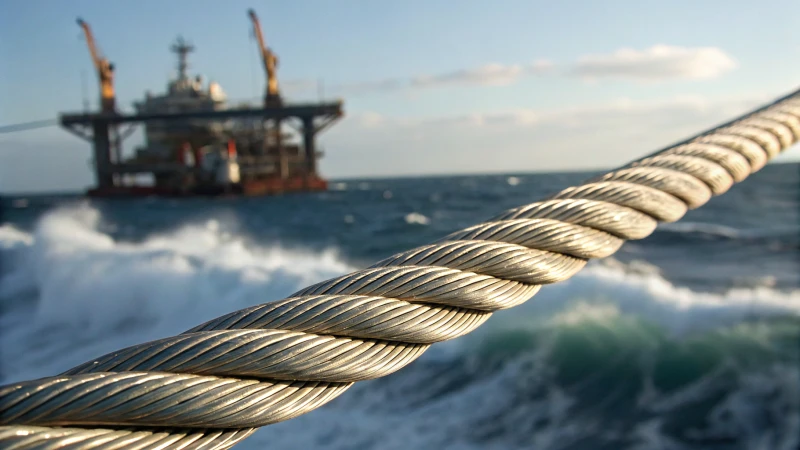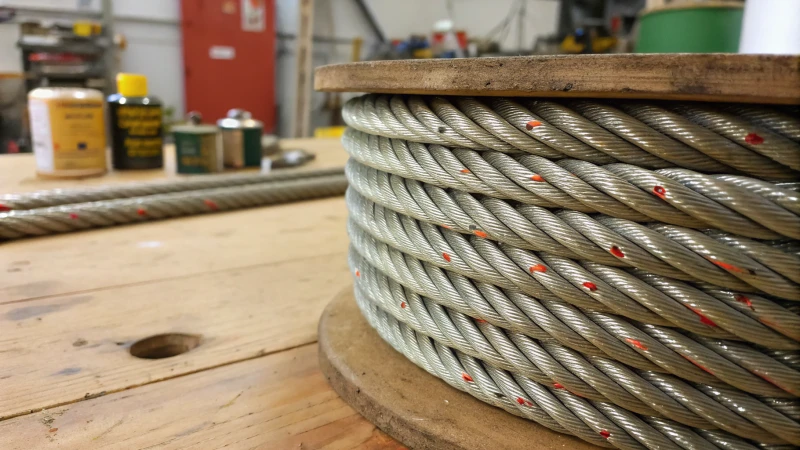
Picture this: standing on an offshore oil rig, surrounded by nothing but the vast ocean, battling the relentless saltwater corrosion on steel wire ropes.
The best corrosion-resistant steel wire rope for offshore oil rigs is AISI 316 stainless steel due to its superior resistance to chloride-induced corrosion. This type of steel contains molybdenum, which enhances its ability to withstand the harsh marine environment.
While AISI 316 stainless steel stands out for its durability and corrosion resistance, navigating the world of steel types and coatings can be daunting. I remember my first procurement task; it was like piecing together a giant puzzle. Let's explore various materials and maintenance tips to ensure your wire ropes perform optimally and last longer in challenging offshore conditions.
AISI 316 steel is the most corrosion-resistant for offshore rigs.True
AISI 316 contains molybdenum, enhancing resistance to saltwater.
All stainless steels resist chloride-induced corrosion equally.False
Different grades, like AISI 316, vary in chloride resistance.
Why Is AISI 316 Stainless Steel Ideal for Offshore Use?
Ever wondered why AISI 316 stainless steel is the go-to for offshore projects? Let me take you through its journey from the depths of the ocean to the pinnacle of industrial use.
AISI 316 stainless steel is perfect for offshore environments due to its exceptional corrosion resistance, thanks to molybdenum. This element helps it outperform other grades like AISI 304 by preventing chloride-induced corrosion in marine settings.

Understanding the Composition of AISI 316 Stainless Steel
So, picture this: I'm standing on an oil rig, the waves crashing beneath, and all I can think about is how the equipment endures such harsh conditions. That's when AISI 316 stainless steel comes into play. It's an austenitic stainless steel that combines chromium, nickel, and molybdenum, giving it a superpower against corrosion, especially from chlorides in seawater.
| Element | Content (%) |
|---|---|
| Chromium | 16-18 |
| Nickel | 10-14 |
| Molybdenum | 2-3 |
Comparing AISI 316 with AISI 304
I remember the first time I compared AISI 316 with AISI 304. It was like comparing a seasoned sailor to a weekend boater. While both are popular, AISI 304 just doesn’t cut it against pitting corrosion—a frequent issue with seawater exposure. Learn more about pitting corrosion1.
Applications in Offshore Environments
Being at sea can be tough on structures like oil rigs and pipelines. AISI 316's composition ensures it stands strong against saltwater and prevents issues like hydrogen embrittlement2. It’s not just about withstanding the elements; it’s about ensuring safety and longevity.
- Oil Rigs: Every component exposed to seawater needs materials that endure continuous exposure.
- Marine Fasteners: The integrity of these fasteners is crucial for keeping everything secure.
Maintenance and Long-term Performance
From my experience, regular inspections and cleaning play a huge role in maintaining the steel's performance. Picture this: a gentle freshwater rinse removing salt deposits, much like a refreshing shower after a long day. And for high-strength needs, coatings or even HSLA steel might be your best friend.
Moreover, adding polymer coatings like polyurethane3 gives an extra layer of protection against mechanical wear and abrasion—crucial for moving parts.
Environmental Considerations
Beyond its durability, I find AISI 316 remarkable for resisting UV radiation and extreme temperatures. This makes it versatile across various climates and applications. Explore more on environmental effects4.
In essence, choosing the right material for offshore environments isn’t just a technical decision—it’s about ensuring safety, reliability, and peace of mind for everyone relying on these structures.
AISI 316 contains 10-14% nickel.True
AISI 316 stainless steel composition includes 10-14% nickel.
AISI 304 is more corrosion-resistant than AISI 316.False
AISI 316 is more corrosion-resistant due to molybdenum content.
How Do Coatings Enhance Corrosion Resistance?
Ever watched a metal gate rust over time and wondered how it could be prevented?
Coatings enhance corrosion resistance by forming a protective barrier that shields the material's surface from moisture and corrosive elements. With options like polymer and metallic coatings, each offers unique benefits based on its composition and application method, ensuring the material stays robust and lasts longer.

Understanding Corrosion Mechanisms
I remember the time I left my bicycle out in the rain for days. When I finally went to fetch it, the once shiny metal was tarnished and rusty. That's corrosion in action! It happens when metals meet moisture, oxygen, and other elements, leading to oxidation that weakens them. Coatings work by blocking these elements from getting to the metal's surface, just like putting a raincoat on my bike would have protected it.
Types of Anti-Corrosion Coatings
There are several kinds of coatings out there to combat corrosion. Take polymer coatings—I think of them as the flexible rain ponchos of the metal world. They include polyurethane and epoxy, known for their adaptability and strong grip, perfect for harsh environments like marine or industrial settings. Then there are metallic coatings, such as galvanization, which act like a brave knight, sacrificing itself to keep the underlying metal safe.
| Coating Type | Benefits | Applications |
|---|---|---|
| Polymer (Epoxy) | Durable, chemical resistant | Marine, Automotive |
| Metallic (Galvanized) | Sacrificial protection | Construction, Infrastructure |
How Coatings Work
Imagine a fortress wall built around a castle—that's what coatings do for metals. They provide a physical shield against corrosive elements, crucial in places with high humidity or salt exposure, such as offshore oil rigs. This protective layer keeps the metal and corrosive agents apart, effectively extending the life of the equipment.
Application Methods
The magic really happens in how a coating is applied. Whether it's spray coating—perfect for precision on tricky surfaces—or dip coating for full coverage on smaller parts, each method ensures even coverage and strong adhesion.
Environmental Considerations
In our world today, being environmentally conscious is more crucial than ever. Some coatings have volatile organic compounds (VOCs), which aren't great for Mother Earth. Luckily, many companies are shifting towards greener solutions that still perform well but leave a smaller environmental footprint.
For more on sustainable options, check out eco-friendly coatings5 that meet modern environmental standards. Also, learning about the impact of VOCs6 can help make smarter choices in industrial settings.
By diving into these factors, industries can effectively implement corrosion management strategies7 that not only enhance performance but also prioritize sustainability.
Polymer coatings are ideal for high-temperature environments.False
Ceramic coatings, not polymer, are better for high temperatures.
Galvanization provides sacrificial protection to metals.True
Galvanization corrodes first, protecting the underlying metal.
How can I best maintain my wire ropes?
Ever wondered how to keep your wire ropes safe and sound for the long haul? Well, it's all about the right maintenance! Let me walk you through some crucial steps that have worked wonders in my experience.
To maintain wire ropes effectively, focus on regular inspections, proper lubrication, and thorough cleaning. These practices help extend the life of your ropes and ensure their safety and reliability.

Inspection and Monitoring
Picture this: I'm standing on a construction site, hard hat on, peering closely at a steel wire rope. It's a routine inspection, but it's anything but ordinary. Regular checks have saved me from countless headaches by catching potential issues before they become major problems. When inspecting, I look for wear, corrosion, or fraying—little signs that can whisper big warnings if you know how to listen.
- Wear and Abrasion: I often find tiny broken wires or flattened spots, which are telltale signs that the rope's been through a tough time.
- Corrosion: Rust spots or discoloration are like red flags waving me down, telling me to take action.
- Fatigue: Kinks or twists in the rope? Yep, those are the culprits of fatigue.
By keeping a keen eye out during these inspections, I've avoided plenty of equipment failures and ensured everything runs smoothly. Frequent inspections can prevent failures by identifying early signs8 of damage.
Lubrication Practices
Once upon a time, I underestimated the power of proper lubrication. That was until I saw firsthand how it reduced friction and extended the life of my ropes. Using a lubricant that penetrates deep into the strands is crucial—it acts like a protective barrier against wear and rust.
| Lubricant Type | Benefits |
|---|---|
| Mineral Oil | Affordable, basic protection |
| Synthetic Oil | High-performance, longer-lasting |
| Grease | Stays in place, ideal for vertical applications |
The right lubricant depends on the environment and load requirements. Trust me, taking the time to choose wisely pays off in the long run.
Cleaning Techniques
A story from my marine days: A rope covered in salt and dirt might as well have been begging for trouble. Cleaning is like hitting a reset button—it keeps the ropes free from contaminants that speed up wear. Rinsing with fresh water after a day in the saltwater is now a habit of mine. And for those heavy-duty days? A mild detergent does wonders without damaging the coating.
- Fresh Water Rinse: This one's my daily go-to for marine settings.
- Detergent Wash: Perfect for those industrial grime-fests.
Regular cleaning not only helps prevent mechanical wear but also keeps everything operating smoothly by removing debris that can cause mechanical wear9.
Replacement Indicators
Despite the best maintenance efforts, sometimes it's just time to say goodbye. Over the years, I've learned to spot when a wire rope has reached its limit:
- More than 10% of wires broken within a single strand—a clear sign it's time for retirement.
- A diameter reduction of over 5% from the original size—it's not pulling its weight anymore.
- Severe rust or corrosion—when it looks more like ancient relics than reliable ropes.
Replacing ropes at the right time ensures safety and efficiency. I've always found that referring to guidelines from industry experts10 gives me peace of mind.
Regular inspections prevent wire rope failures.True
Frequent checks identify early signs of damage, avoiding breakdowns.
Mineral oil is the best lubricant for all environments.False
Mineral oil offers basic protection; synthetic oils suit harsh conditions.
How do I evaluate supplier reliability for steel wire ropes?
Choosing the right supplier for steel wire ropes can feel like navigating a maze. Trust me, I've been there—juggling safety, quality, and deadlines. Here's how I ensure my supplier is up to snuff.
To evaluate supplier reliability for steel wire ropes, I focus on product quality, delivery performance, and customer support. I also look into certifications, past client reviews, and compliance with industry standards to ensure a trustworthy supply chain.

Assessing Product Quality
When I first started out, I learned the hard way that not all steel wire ropes are created equal. To avoid costly mistakes, I now prioritize examining the quality of the products. I specifically look for certifications11 from recognized bodies, ensuring they meet international standards like ISO 9001. Here's what I pay attention to:
- AISI 316 Stainless Steel: This type is my go-to for projects near water because of its excellent corrosion resistance.
- High-Strength Low-Alloy Steel: I make sure it's properly coated to stand up against corrosion while providing the high tensile strength my projects demand.
A table comparing steel types can help:
| Steel Type | Features |
|---|---|
| AISI 316 Stainless Steel | Superior corrosion resistance |
| HSLA | High tensile strength |
| Galvanized Steel | Economical but requires regular checks |
Delivery Performance
I've learned that timely delivery can make or break a project schedule. I've had my fair share of frantic phone calls and sleepless nights due to late deliveries. Now, I always check the supplier's track record for on-time deliveries. Testimonials and data from previous clients about delivery consistency have become my secret weapons. Suppliers who offer flexible logistics solutions like just-in-time delivery12 give me peace of mind.
Evaluating Customer Support
Reliable customer support is essential. A few years back, I faced a technical glitch during a critical phase of a project, and the supplier's quick assistance saved the day. Now, I always ensure they offer technical assistance, post-sale services, and regular updates on product innovations. Their readiness to engage in problem-solving and provide training sessions speaks volumes about their commitment.
Analyzing Compliance and Certifications
Compliance is non-negotiable. I verify suppliers hold necessary certifications13 and adhere to safety regulations. This ensures the steel wire ropes are not only top-notch but also safe for the demanding environments my projects often entail.
Reviewing Client Testimonials and Case Studies
I never underestimate the power of client testimonials and case studies. Positive feedback on product performance, durability under harsh conditions, and excellent customer service are key indicators of reliability that I've come to rely on.
Maintenance and After-Sales Service
A few years back, a proactive maintenance plan from a supplier extended the life of my steel wire ropes significantly. Now, I consider suppliers who offer comprehensive maintenance and after-sales service plans a must-have. Regular inspection and lubrication14 can make all the difference in ensuring safety and prolonging rope life.
AISI 316 steel is best for marine environments.True
AISI 316 stainless steel offers superior corrosion resistance, ideal for marine use.
HSLA steel is known for low tensile strength.False
High-Strength Low-Alloy (HSLA) steel is known for high tensile strength.
Conclusion
AISI 316 stainless steel wire rope is ideal for offshore oil rigs due to its exceptional corrosion resistance, particularly against chloride-induced corrosion from saltwater environments.
-
Learning about pitting corrosion emphasizes why AISI 316 is chosen over other grades for offshore use. ↩
-
Exploring hydrogen embrittlement aids in recognizing the durability benefits of AISI 316. ↩
-
Understanding the advantages of polyurethane coatings can highlight additional protective measures. ↩
-
Exploring environmental impacts clarifies the broad suitability of AISI 316 in varied conditions. ↩
-
Discover sustainable coating solutions that minimize environmental impact while providing excellent protection against corrosion. ↩
-
Learn about the environmental effects of VOCs in coatings to make informed choices about sustainable products. ↩
-
Explore comprehensive strategies for managing corrosion in industrial applications. ↩
-
This link offers detailed guidance on identifying early damage signs in wire ropes, enhancing your inspection routine. ↩
-
Explore methods to prevent mechanical wear on wire ropes, crucial for extending their service life. ↩
-
Learn when to replace wire ropes by following industry standards to ensure safety and performance. ↩
-
Learn about essential certifications like ISO 9001 that indicate high-quality manufacturing standards. ↩
-
Discover the advantages of timely deliveries in maintaining project schedules. ↩
-
Explore the standards that ensure safety and quality in steel wire ropes. ↩
-
Find out how maintenance practices can enhance rope durability and safety. ↩

